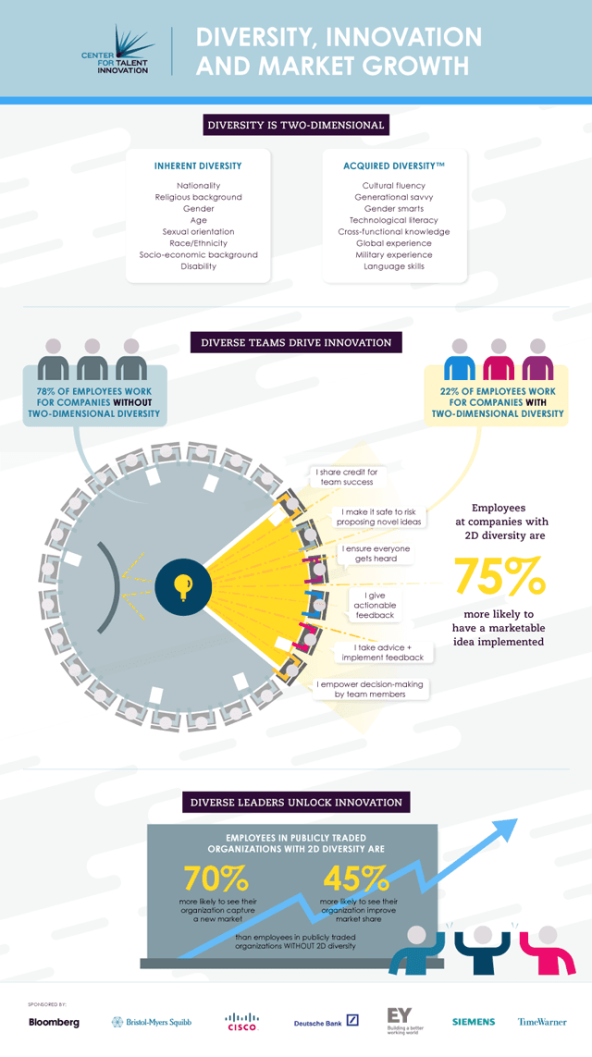For leaders of multinational companies, innovation is the engine of market growth. Nothing increases market share or captures new markets like a new product, process, or service.
But what—or who—consistently drives innovation in corporate America?
Not the likes of Mark Zuckerberg, actually. New research from the Center for Talent Innovation suggests that the engine of innovation resides in the collective genius of diverse teams managed by leaders who value perspectives and approaches outside their own experience or expertise. With input from 1,800 survey respondents, 40 Fortune 500 case studies, and 100-plus innovators, we found that companies with inherently diverse employees and leaders who behave inclusively were likeliest to open a new market in the last year or expand their share of an existing one. A vertically diverse workforce, not boy genius, is what drives market growth through serial innovation.
Let’s be clear about what we mean by diverse. In our study, we scrutinized two kinds of difference: inherent and acquired. Inherent diversity describes “embodied” difference—traits you were born with and have been consequently conditioned by, such as gender, ethnicity, and sexual orientation. An inherently diverse workforce is more representative in its numbers of women, minorities, and gays. Acquired diversity, in contrast, is not who you are but how you act as a result of what you’ve experienced or learned. Living abroad, for instance, can lead you to appreciate other cultures; growing up with a gay sibling can increase your awareness of the opportunities as well as the challenges associated with an LGBT identity.

We found that publicly traded companies with both inherent and acquired diversity in leadership out-innovate and out-perform the competition. They were 70 percent more likely than companies lacking this two-dimensional diversity to have captured a new market and 45 percent more likely to have improved market share (see graphic below).
Why does two-dimensional diversity confer such a competitive edge? Our findings suggest a powerful dynamic at work between diverse employees and leaders who know how to unlock everyone’s contribution. Employees who are inherently diverse bring to their team an innate understanding of “points of pain,” or the unmet needs in underleveraged markets. Specifically, when at least one team member embodies the diversity of the team’s end user, the entire team better understands the client or customer they’re innovating for. So a team with a member who matches the ethnicity of the team’s client, for example, is 152 percent more likely to understand that client than a team lacking that representative.
But it takes leaders who value difference and prize “outsider” perspectives to elicit these insights, and then give proposed solutions the backing they need to develop and deploy them into the marketplace. Bottom line: Leaders with inherent and acquired diversity help establish the “speak-up culture” that is so critical to unleashing the full innovative capacity of each employee. Why? From our study we infer that, because they give diverse voices equal airtime, they are more than twice as likely as non-inclusive leaders to unleash value-driving insights. Because they make sure that each team member gets constructive and supportive feedback, they are nearly twice as likely as non-inclusive leaders to elicit breakthrough ideas. And because they listen to contrarian input and will course-correct based on it, they’re nearly twice as likely as non-inclusive leaders to arrive at effective solutions.
With leaders who exhibit these inclusive behaviors, we found that employees were 3.5 times more likely (67 percent vs. 15 percent) to contribute their full innovative potential. Indeed, our study showed that at companies where executives have two-dimensional diversity, employees were 75 percent more likely than employees at non-diverse companies to see their ideas realized as market innovation. For this reason, it is ultimately diversity in senior leadership—not just diversity in the lower ranks—that correlates to superior performance and market growth.
Our findings in aggregate constitute a compelling argument for diversifying leadership. A wealth of great ideas translates into a wealth of market share only if leadership values diversity as much as innovation.
Support SSIR’s coverage of cross-sector solutions to global challenges.
Help us further the reach of innovative ideas. Donate today.
Read more stories by Sylvia Ann Hewlett, Melinda Marshall & Laura Sherbin.

